Information
LHCb-PAPER-2015-038
CERN-PH-EP-2015-244
arXiv:1510.01951 [PDF]
(Submitted on 07 Oct 2015)
Phys. Rev. D92 (2015) 112009
Inspire 1396563
Tools
Abstract
The decay $B^0\to \psi(2S) K^+\pi^-$ is analyzed using $\rm 3 fb^{-1}$ of $pp$ collision data collected with the LHCb detector. A model-independent description of the $\psi(2S) \pi$ mass spectrum is obtained, using as input the $K\pi$ mass spectrum and angular distribution derived directly from data, without requiring a theoretical description of resonance shapes or their interference. The hypothesis that the $\psi(2S)\pi$ mass spectrum can be described in terms of $K\pi$ reflections alone is rejected with more than 8$\sigma$ significance. This provides confirmation, in a model-independent way, of the need for an additional resonant component in the mass region of the $Z(4430)^-$ exotic state.
Figures and captions
|
Spectrum of the $\psi {(2S)} K \pi$ system invariant mass. Black dots are the data, the continuous (blue) line represents the fit result and the dashed (red) line represents the background component. |
B2KPiP[..].pdf [23 KiB] HiDef png [142 KiB] Thumbnail [127 KiB] |
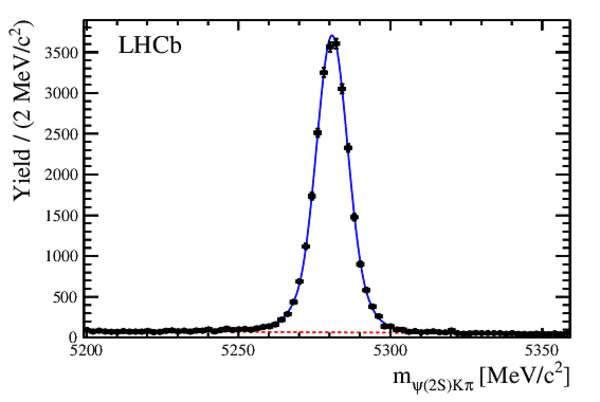
|
|
The 2D efficiency shown in the following planes: (top-left) ($ m _{ K \pi} $,$\cos\theta_{K^{*0}}$), (top-middle) ($ m _{ K \pi} $,$ \mathrm{\Delta\phi_{\it{ K }\pi,\mu\mu}} $), (top-right) ($ m _{ K \pi} $,$\mathrm{cos{\theta}_{\psi {(2S)} }} $), (bottom-left) ($\cos\theta_{K^{*0}}$,$\mathrm{cos{\theta}_{\psi {(2S)} }} $), (bottom-middle) ($\cos\theta_{K^{*0}}$,$ \mathrm{\Delta\phi_{\it{ K }\pi,\mu\mu}} $), (bottom-right) ($\mathrm{cos{\theta}_{\psi {(2S)} }} $,$ \mathrm{\Delta\phi_{\it{ K }\pi,\mu\mu}} $). Corrections for the efficiency are applied in the 4D space; the 2D plots allow visualization of their behavior. |
Eff2D_[..].pdf [17 KiB] HiDef png [314 KiB] Thumbnail [264 KiB] |
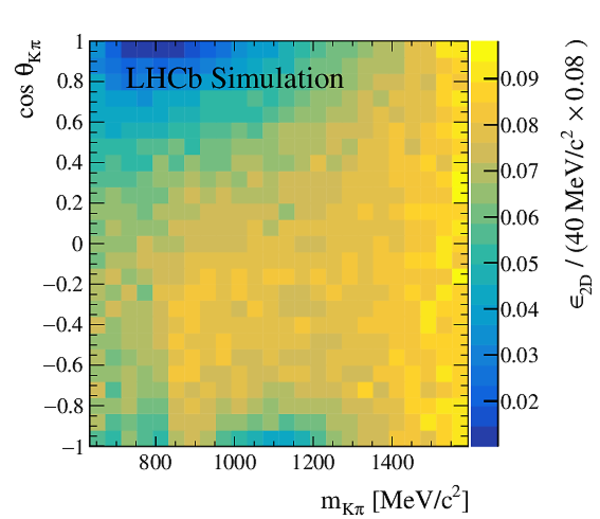
|
|
Eff2D_[..].pdf [15 KiB] HiDef png [246 KiB] Thumbnail [196 KiB] |
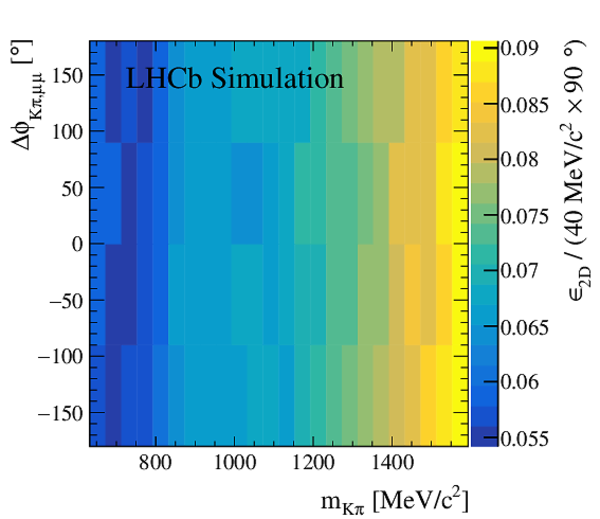
|
|
|
Eff2D_[..].pdf [15 KiB] HiDef png [262 KiB] Thumbnail [212 KiB] |

|
|
|
Eff2D_[..].pdf [15 KiB] HiDef png [237 KiB] Thumbnail [193 KiB] |
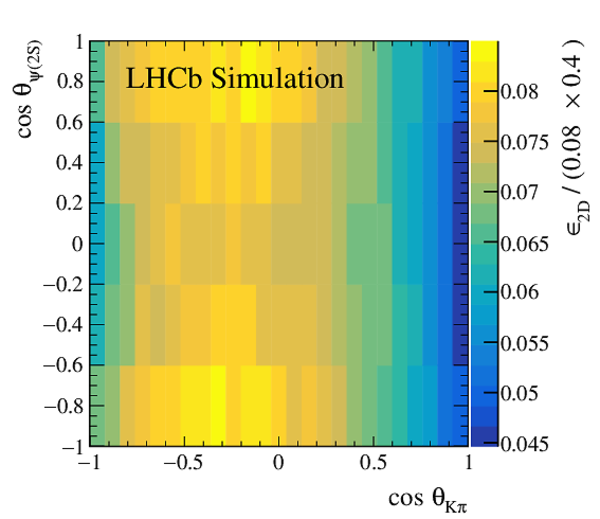
|
|
|
Eff2D_[..].pdf [15 KiB] HiDef png [225 KiB] Thumbnail [177 KiB] |

|
|
|
Eff2D_[..].pdf [14 KiB] HiDef png [185 KiB] Thumbnail [158 KiB] |

|
|
|
The $\psi {(2S)} \pi$ invariant mass resolution as determined from simulated data (red dots). The continuous line is a spline-based interpolation. |
res_Pi[..].pdf [14 KiB] HiDef png [121 KiB] Thumbnail [122 KiB] |

|
|
Distributions of (left) $ m _{ K \pi}$ and (right) $\cos\theta_{K^{*0}}$, after background subtraction and efficiency correction. |
KPi_M_[..].pdf [15 KiB] HiDef png [98 KiB] Thumbnail [56 KiB] |

|
|
CosThetaK.pdf [15 KiB] HiDef png [95 KiB] Thumbnail [58 KiB] |

|
|
|
The two-dimensional distributions ( $ m _{ K \pi}$ ,$\cos\theta_{K^{*0}}$) and ($m_{\psi {(2S)} \pi}$,$\mathrm{cos{\theta}_{\psi {(2S)} }} $) are shown in the left and the right plots, respectively, after background subtraction and efficiency correction. |
hist_2[..].pdf [25 KiB] HiDef png [353 KiB] Thumbnail [270 KiB] |

|
|
PiPsi_[..].pdf [34 KiB] HiDef png [552 KiB] Thumbnail [479 KiB] |
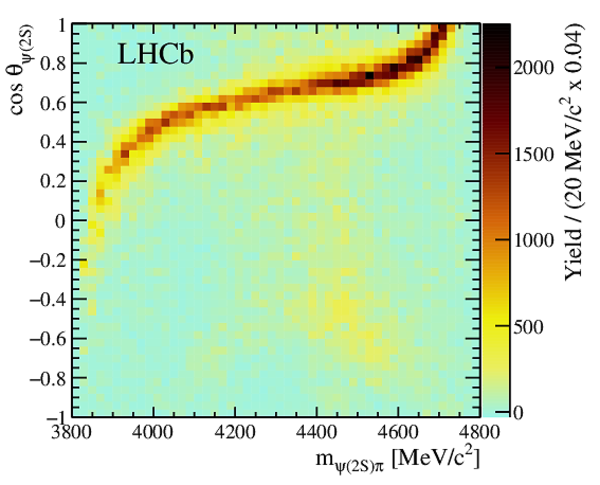
|
|
|
Dependence on $ m _{ K \pi}$ of the first six $ K \pi $ moments of the $ B ^0 \rightarrow \psi {(2S)} K ^+ \pi ^- $ decay mode as determined from data. |
PU_1_Kpi.pdf [15 KiB] HiDef png [131 KiB] Thumbnail [137 KiB] |

|
|
PU_2_Kpi.pdf [15 KiB] HiDef png [134 KiB] Thumbnail [141 KiB] |
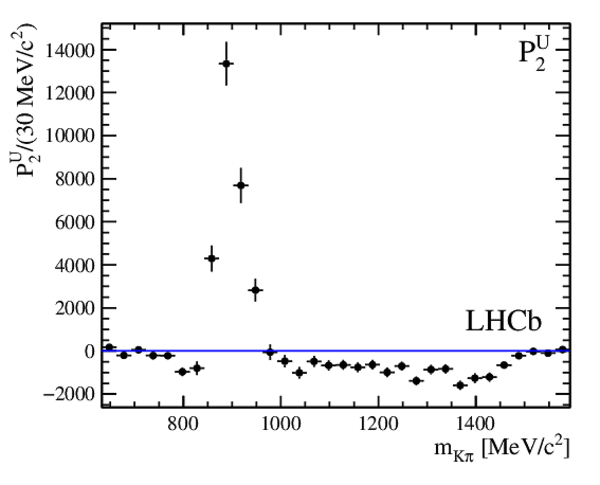
|
|
|
PU_3_Kpi.pdf [16 KiB] HiDef png [130 KiB] Thumbnail [140 KiB] |

|
|
|
PU_4_Kpi.pdf [15 KiB] HiDef png [125 KiB] Thumbnail [133 KiB] |
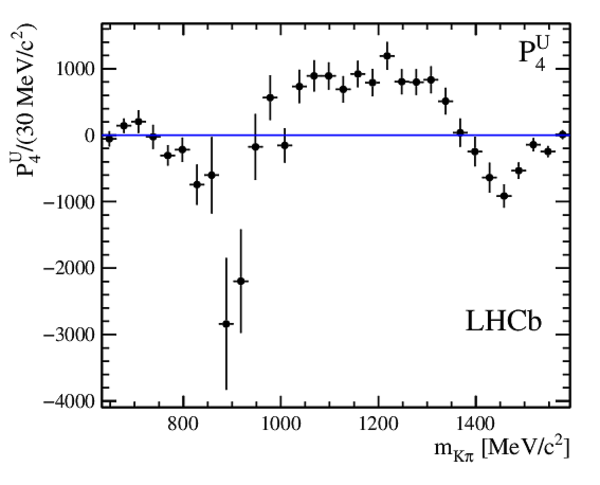
|
|
|
PU_5_Kpi.pdf [15 KiB] HiDef png [122 KiB] Thumbnail [128 KiB] |

|
|
|
PU_6_Kpi.pdf [16 KiB] HiDef png [137 KiB] Thumbnail [147 KiB] |

|
|
|
First six normalized $ K \pi $ moments of the $ B ^0 \rightarrow \psi {(2S)} K ^+ \pi ^- $ decay mode as a function of $ m _{ K \pi}$ . The shaded (yellow) bands indicate the $\pm 1\sigma$ variations of the moments. |
PN_1_Kpi.pdf [16 KiB] HiDef png [308 KiB] Thumbnail [222 KiB] |

|
|
PN_2_Kpi.pdf [16 KiB] HiDef png [299 KiB] Thumbnail [223 KiB] |

|
|
|
PN_3_Kpi.pdf [16 KiB] HiDef png [295 KiB] Thumbnail [214 KiB] |

|
|
|
PN_4_Kpi.pdf [16 KiB] HiDef png [299 KiB] Thumbnail [222 KiB] |

|
|
|
PN_5_Kpi.pdf [16 KiB] HiDef png [265 KiB] Thumbnail [209 KiB] |
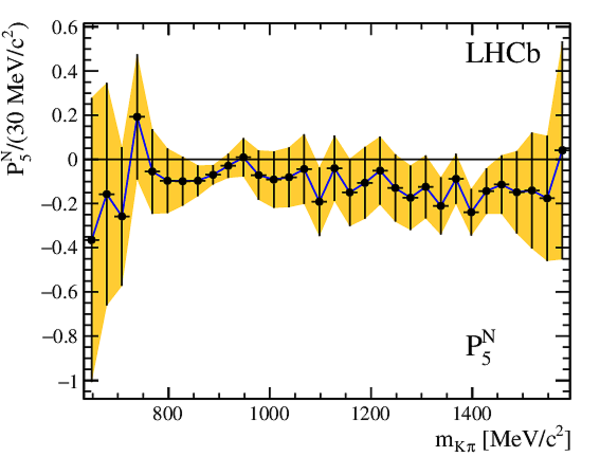
|
|
|
PN_6_Kpi.pdf [16 KiB] HiDef png [252 KiB] Thumbnail [186 KiB] |
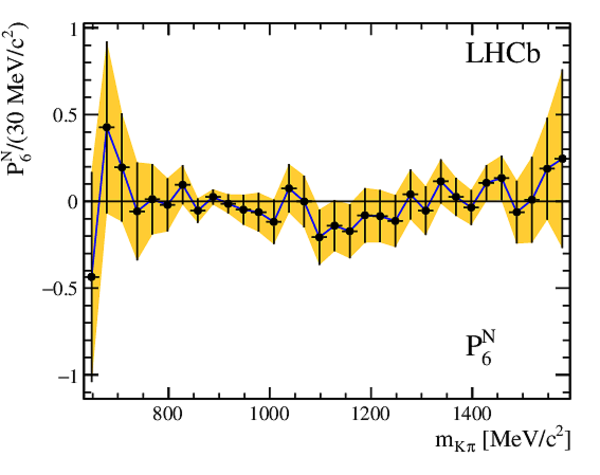
|
|
|
Background subtracted and efficiency corrected spectrum of $m_{\psi {(2S)} \pi}$. Black points represent data. Superimposed are the distributions of the Monte Carlo simulation: the dotted (black) line corresponds to the pure phase-space case; in the dash-dotted (red) line the $ m _{ K \pi}$ spectrum is weighted to reproduce the experimental distribution; in the continuous (blue) line the angular structure of the $ K \pi $ system is incorporated using Legendre polynomials up to (left) $ l_{\text{max}} =4$ and (right) $ l_{\text{max}} =6$. The shaded (yellow) bands are related to the uncertainty on normalized moments, which is due to the statistical uncertainty that comes from the data. Therefore the two uncertainties should not be combined when comparing data and Monte Carlo predictions. See text for further details. |
COMPAR[..].pdf [19 KiB] HiDef png [301 KiB] Thumbnail [223 KiB] |

|
|
COMPAR[..].pdf [19 KiB] HiDef png [304 KiB] Thumbnail [221 KiB] |
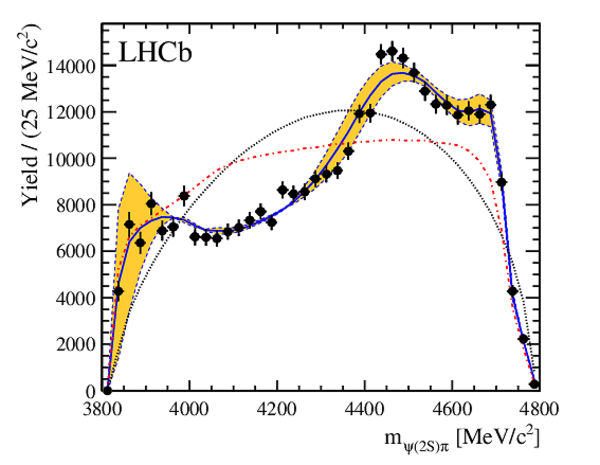
|
|
|
The experimental spectrum of $m_{\psi {(2S)} \pi}$ is shown by the black points. Superimposed are the distributions of the Monte Carlo simulation: the dotted(black) line corresponds to the pure phase-space case; in the dash-dotted (red) line the $ m _{ K \pi}$ spectrum is weighted to reproduce the experimental distribution; in the continuous (blue) line the angular structure of the $ K \pi $ system is incorporated using Legendre polynomials with index $ l_{\text{max}} $ variable according to $ m _{ K \pi}$ as described in \autoref{eq:slices}, reaching up to $ l_{\text{max}} =4$. The shaded (yellow) bands are related to the uncertainty on normalized moments, which is due to the statistical uncertainty that comes from the data. Therefore the two uncertainties should not be combined when comparing data and Monte Carlo predictions. See text for further details. |
COMPAR[..].pdf [19 KiB] HiDef png [308 KiB] Thumbnail [226 KiB] |

|
|
Black points represent the experimental distributions of $m_{\psi {(2S)} \pi}$ for the indicated $ m _{ K \pi}$ intervals. The dash-dotted (red) line is obtained by modifying the $ m _{ K \pi}$ spectrum of the phase-space simulation according to the $ m _{ K \pi}$ experimental spectrum. In the continuous (blue) line the angular structure of the $ K \pi $ system is incorporated using Legendre polynomials with variable index $ l_{\text{max}} $ according to \autoref{eq:slices}. The shaded (yellow) bands are related to the uncertainty on normalized moments, which is due to the statistical uncertainty that comes from the data. Therefore the two uncertainties should not be combined when comparing data and Monte Carlo predictions. See text for further details. |
COMPAR[..].pdf [18 KiB] HiDef png [278 KiB] Thumbnail [218 KiB] |

|
|
COMPAR[..].pdf [18 KiB] HiDef png [283 KiB] Thumbnail [208 KiB] |

|
|
|
COMPAR[..].pdf [19 KiB] HiDef png [305 KiB] Thumbnail [236 KiB] |

|
|
|
COMPAR[..].pdf [17 KiB] HiDef png [251 KiB] Thumbnail [188 KiB] |
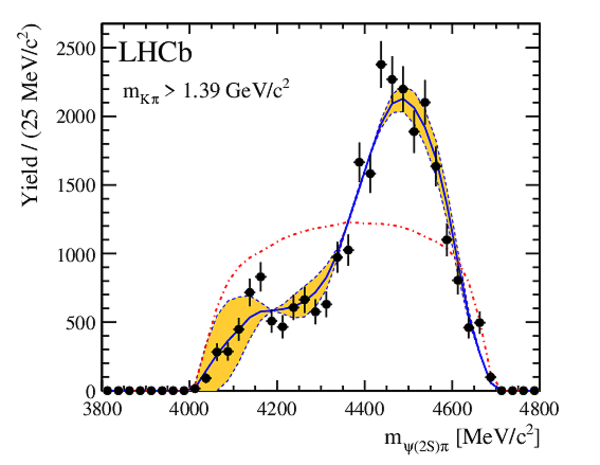
|
|
|
The experimental spectrum of $m_{\psi {(2S)} \pi}$ is shown by the black points. Superimposed are the distributions of the Monte Carlo simulation: the dotted (black) line corresponds to the pure phase space case; in the dash-dotted (red) line the $ m _{ K \pi}$ spectrum is weighted to reproduce the experimental distribution; in the continuous (blue) line the angular structure of the $ K \pi $ system is incorporated using Legendre polynomials up to $ l_{\text{max}} =30$ which implies a full description of the spectrum features even if it corresponds to an unphysical configuration of the $ K \pi $ system. The shaded (yellow) bands are related to the uncertainty on normalized moments. |
COMPAR[..].pdf [19 KiB] HiDef png [335 KiB] Thumbnail [236 KiB] |
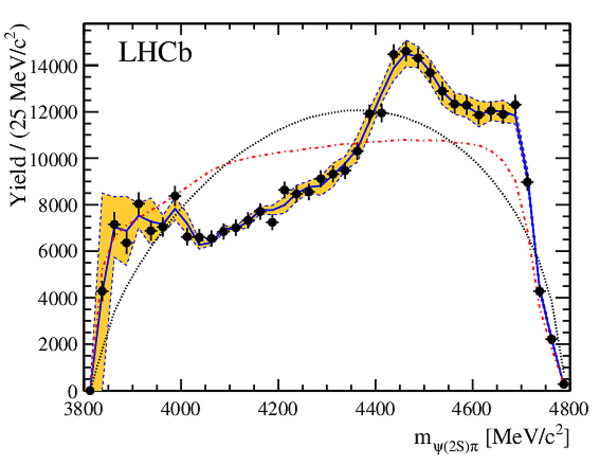
|
|
Distributions of $-2\Delta\textrm{NLL}$ for the pseudoexperiments (black dots), fitted with a Gaussian function (dashed red line), in three different configurations of the $ K \pi $ system angular contributions: (left) $ l_{\text{max}} =4$, (middle) $ l_{\text{max}} =6$ and (right) $ l_{\text{max}} $ variable according to \autoref{eq:slices}. The black arrow represents the $-2\Delta\textrm{NLL}$ value obtained on data. |
NLL_LO[..].pdf [26 KiB] HiDef png [174 KiB] Thumbnail [146 KiB] |

|
|
NLL_LO[..].pdf [27 KiB] HiDef png [183 KiB] Thumbnail [153 KiB] |

|
|
|
NLL_LO[..].pdf [26 KiB] HiDef png [176 KiB] Thumbnail [149 KiB] |

|
|
|
Distributions of $-2\Delta\textrm{NLL}$ for the pseudoexperiments (black dots), fitted with a Gaussian function (dashed red line), for the region $1000 {\mathrm{ Me V /}c^2} < m _{ K \pi} <1390 {\mathrm{ Me V /}c^2} $ in three different configurations of the $ K \pi $ system angular contributions: (left) $ l_{\text{max}} =4$, (middle) $ l_{\text{max}} =6$ and (right) $ l_{\text{max}} $ variable according to \autoref{eq:slices}. The black arrow represents the $-2\Delta\textrm{NLL}$ value obtained on data. |
NLL_LO[..].pdf [25 KiB] HiDef png [171 KiB] Thumbnail [140 KiB] |
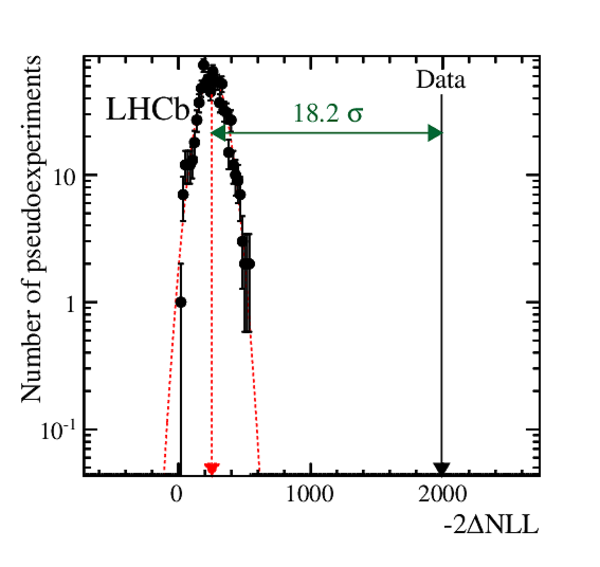
|
|
NLL_LO[..].pdf [26 KiB] HiDef png [172 KiB] Thumbnail [143 KiB] |

|
|
|
NLL_LO[..].pdf [26 KiB] HiDef png [169 KiB] Thumbnail [142 KiB] |

|
|
|
Animated gif made out of all figures. |
PAPER-2015-038.gif Thumbnail |

|
Tables and captions
|
Results of the fit to the invariant mass spectrum of the $\psi {(2S)} K \pi$ system. The signal and the background yields are calculated in the signal region defined by the interval of $\pm 2\sigma_{ B ^0 }$ around $M_{ B ^0 }$. |
Table_1.pdf [51 KiB] HiDef png [60 KiB] Thumbnail [27 KiB] tex code |

|
|
Experimental resolution of kinematical quantities, as estimated from Monte Carlo simulations. |
Table_2.pdf [66 KiB] HiDef png [133 KiB] Thumbnail [47 KiB] tex code |

|
|
Mass, width, spin and parity of resonances known to decay to the $ K \pi $ final state [5]. The list is limited to masses up to just above the maximum invariant mass for the $ K \pi $ system which, in the decay $ B ^0 \rightarrow \psi {(2S)} K ^+ \pi ^- $, is $1593 {\mathrm{ Me V /}c^2} $. |
Table_3.pdf [51 KiB] HiDef png [93 KiB] Thumbnail [46 KiB] tex code |

|
|
Significance, {\it S}, in units of standard deviations, at which the hypothesis that $m_{\psi {(2S)} \pi}$ data can be described as a reflection of the $ K \pi $ system angular structure is excluded, for different configurations of the $ K \pi $ system angular contributions. In the second column the whole $ m _{ K \pi} $ spectrum has been analyzed while in the third one the specified $ m _{ K \pi} $ cut is applied. |
Table_4.pdf [46 KiB] HiDef png [28 KiB] Thumbnail [12 KiB] tex code |

|
Created on 26 April 2024.
